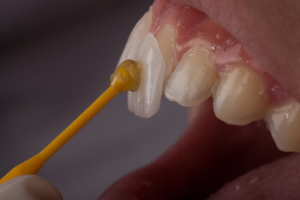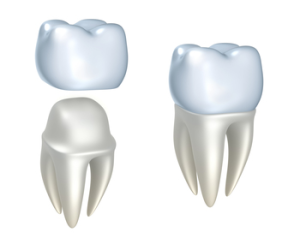When seeking cosmetic dentistry solutions in Australia, two terms often arise in conversations – dental veneers and dental crowns. These terms may sound interchangeable, but they serve different purposes and are used to address varying dental concerns. So, let’s plunge into the heart of the matter and discuss “veneers vs. crowns: what’s the difference?”
What are Dental Veneers?
Dental veneers, often made from porcelain or composite resin, are thin layers affixed to the front surface of your tooth. Primarily used for cosmetic improvement, they aim to enhance the appearance of crooked or chipped teeth, ensuring that your smile is nothing short of perfect. These veneers offer an ideal solution for those minor imperfections, especially on your front teeth.
What about Dental Crowns?
Moving on from the realm of veneers, we find dental crowns reigning supreme. Unlike a veneer that covers only the tooth surface, a dental crown covers the entire tooth. It acts as a protective cap for weakened teeth, cracked teeth, or even after root canal treatment. Crowns can be made from several different materials, such as porcelain and ceramic crowns, metal alloy, or a blend of porcelain fused to metal.
The Evolution of Cosmetic Dentistry: A Historical Perspective
Delving a bit into the annals of history, both veneers and crowns have undergone significant transformations in their design, application, and materials used. The story of cosmetic dentistry, to which both these treatments belong, is as fascinating as the procedures themselves.
In ancient civilisations, the desire for a perfect smile wasn’t unfamiliar. The Etruscans, for instance, utilised gold as their preferred dental crown material as early as 700 BC! They recognised the importance of replacing missing or damaged teeth, not just for functional reasons but also for aesthetic appeal. Fast forward a few centuries, and materials like ivory, bone, and even seashells were experimentally used for dental restorations.
The concept of veneers isn’t entirely modern, either. While the composite resin and porcelain veneers we’re familiar with today originated in the 20th century, the desire to cover up dental flaws isn’t new. Early civilisations used rudimentary methods to mask dental concerns. For instance, the Japanese had a unique practice of intentionally blackening their teeth, known as “Ohaguro”, which was seen as a mark of beauty and status.
As we appreciate the finesse of today’s dental veneers and crowns, it’s intriguing to reflect on their journey. From the gold crowns of the Etruscans to the porcelain and ceramic wonders of today, dental restorations have been a testament to humankind’s relentless quest for aesthetic perfection and functional efficacy.
Key Differences Between Veneers and Crowns
Materials Used: The Pros and Cons
Porcelain
Porcelain is a favourite for both veneers and crowns because of its close resemblance to natural teeth. The advantage of porcelain veneers is their translucency which provides a natural appearance. Porcelain crowns, on the other hand, benefit from their strength and resilience.
- Pros: Natural appearance, stain-resistant, durable.
- Cons: More expensive, can be brittle under extreme force, requires more removal of tooth structure for placement.
Composite Resin
Composite veneers and crowns can often be fabricated and applied in just one visit to the dental office. They’re less expensive than their porcelain counterparts but don’t have the same lifespan.
- Pros: Less expensive, less tooth structure removal, repairs are easier.
- Cons: Not as durable, more prone to staining, might not appear as natural as porcelain.
Metal Crowns
Metal crowns, often made from alloys, are resilient and long-lasting. They’re usually recommended for back teeth due to their metallic appearance.
- Pros: Highly durable, minimal tooth removal, less wear to opposing teeth.
- Cons: Metallic colour might cause allergic reactions in some individuals.
Porcelain Fused to Metal Crowns
These offer the strength of metal, while the porcelain gives them a tooth-like appearance.
- Pros: Strong and aesthetically appealing.
- Cons: The metal might show through as a dark line, especially at the gum margin.
Procedure Insights
Veneers
Once you and your dentist decide on veneers, the next steps involve the following:
- Preparation: A small amount of tooth enamel is removed to make room for the veneer. An impression of your tooth is then sent to a dental lab so your custom-made veneers can be created.
- Bonding: Before cementing the veneer, your dentist will temporarily place it to check the fit and colour. Adjustments can be made at this stage. The tooth is then cleaned, polished, and filed to strengthen bonding. The veneer is attached using a special light-activated dental cement.
Crowns
The procedure for a dental crown involves a couple of visits:
Preparation: This involves removing parts of the damaged tooth, then taking an impression, which will be sent to the dental laboratory so your crown can be created. Meanwhile, a temporary crown protects the ground-down tooth.
Placement: On your next visit, the temporary crown is taken off, and the permanent crown is placed over the existing tooth, ensuring a comfortable fit and bite.
Maintenance and Care
 Dental Veneers
Dental Veneers
Even though veneers might seem like a permanent solution for a perfect smile, they require care:
- Oral Hygiene: Continue with regular brushing, flossing, and dental checkups.
- Avoid Hard Foods: It’s best to skip chewing hard items like ice or opening packages with your teeth.
- No Grinding: If you have a habit of grinding your teeth, discuss the use of a night guard with your dentist.
Dental Crowns
They’re durable but not indestructible. Proper care can extend their lifespan:
- Regular Dental Hygiene: Essential to avoid dental problems in the crowned tooth or adjoining teeth.
- Avoid Chewing Hard Items: This can dislodge or damage the crown.
- Avoid Sticky Foods: These can potentially pull off the crown.
In the Realm of Cost: Navigating the Investment
Dental veneers and crowns, while offering numerous benefits, do come with an associated cost. It’s essential to navigate this aspect with clarity:
- Veneers vs. Crowns Cost Implications: Generally, veneers might be slightly more affordable than crowns, but this can vary based on the dental office, location, and the chosen material.
- Insurance Nuances: While some dental insurance plans might cover some of the cost if the procedure is deemed medically necessary (for example, restoring a damaged tooth), purely cosmetic procedures might not receive the same coverage. It’s prudent for patients to discuss this with their insurance providers.
- Financing Options: Many dental offices now offer financing options or payment plans, making these treatments more accessible to a broader range of patients.
Potential Issues and Solutions
- Sensitivity: After getting veneers or crowns, some might experience sensitivity to hot and cold. This usually subsides within a few days. If it persists, consulting with your dentist is crucial.
- Loose or Dislodged Restoration: If your veneer or crown feels loose, it’s essential to see your dentist immediately to avoid any further complications.
- Discolouration: Over time, the dental cement used to bond veneers or crowns can stain. Regular cleanings can help in reducing such risks.
When Should You Opt for Veneers?
If you’re seeking a cosmetic dentist to address those slightly crooked teeth, or minor gaps or just want to brighten up your smile, veneers might be the solution. They’re less invasive than crowns, allowing the original tooth to stay mostly intact.
And Crowns?
If you’ve had a root canal, or your tooth has decayed or become severely damaged, crowns might be recommended. Crowns are also preferred when there’s a need to brace adjoining teeth or use them in conjunction with a dental bridge as a replacement tooth.
Potential Risks and Considerations
Every dental restoration procedure has its risks and benefits. It’s essential to remember that while veneers only cover the front of the tooth, crowns encapsulate the whole tooth. Hence, if there’s a dental issue with only a part of your tooth exposed, a veneer might be your go-to. Conversely, if the entire tooth is compromised, be it due to a root canal or extensive decay, crowning would be a wise choice.
And though dental cement firmly holds veneers and crowns, there’s a slight chance they could dislodge. Regular dental checkups are crucial to ensure they remain in place and serve their purpose.
Veneers vs Crowns: Delving Deeper into Materials, Innovations, and the Patient Experience
While our previous sections have discussed various facets of veneers and crowns, let’s journey a step further. The cosmetic dentistry industry is continually evolving, with innovations enhancing the patient experience. Beyond understanding the foundational differences between the two, diving into recent advancements and what patients can expect is crucial.
The Modern Innovations Shaping Veneers and Crowns
 With technology continually advancing, cosmetic dentistry isn’t left behind. Let’s talk about some game-changers:
With technology continually advancing, cosmetic dentistry isn’t left behind. Let’s talk about some game-changers:
- Digital Impressions: Gone are the days when patients had to bite into a gooey paste to create an impression. Many dental offices now utilise digital impression systems, providing enhanced accuracy and comfort.
- Computer-Aided Design and Computer-Aided Manufacturing Technology: This has have revolutionised how veneers and crowns are crafted. Some dental offices can now design and craft a crown in a single appointment, reducing the need for temporary crowns.
- 3D Printing: While still in its infancy in dental applications, 3D printing has potential, especially when combined with digital impressions. This technology could reduce wait times and further improve accuracy.
Patient Experience: Setting Realistic Expectations
- Initial Discomfort: Feeling minimal discomfort or sensitivity right after getting veneers or crowns is natural. However, this typically subsides within a few days.
- Maintenance Needs: While veneers and crowns are durable, they aren’t indestructible. Patients should be counselled on avoiding hard foods like candies or ice, especially immediately post-procedure.
- Longevity Expectations: While dental crowns generally last longer, with many serving the patient well for a decade or more, veneers too can have significant longevity, especially if taken care of properly. Educating patients on the typical lifespan of their chosen solution can help set clear expectations.
- Potential for Replacement: Patients must understand that while veneers and crowns offer a long-term solution, they might require replacement down the line, especially if there’s wear and tear, damage, or other dental concerns.
- Aesthetic Outcomes: Porcelain veneers and crowns offer fantastic aesthetic results. However, patients should be briefed on the potential for slight shade variations, especially if they’re prone to consuming stain-causing food and beverages.
Veneers FAQs
Do Veneers Require Special Care?
Veneers don’t need any special care. Regular dental checkups, brushing, flossing, and maintaining good oral hygiene will ensure their longevity. However, avoiding biting on hard items like ice or hard candy is recommended to prevent potential damage.
Will Veneers Look Fake or too Bright?
A professional cosmetic dentist will match veneers to the natural shade of your teeth, ensuring they blend seamlessly. The goal is to enhance, not to make it apparent that dental work has been done.
Can Veneers Correct Crooked Teeth?
Veneers can be used to address mildly crooked or gapped teeth, offering a quicker solution than braces. They’re sometimes referred to as “instant orthodontics” for this reason.
Are Veneers Reversible?
Porcelain veneers are considered semi-permanent and are not reversible. This is because a small amount of enamel is removed during the procedure. Composite resin veneers are less invasive and might be reversible, but viewing veneers as a long-term decision is best.
How Often Might Veneers Need Replacement?
With proper care, veneers, especially porcelain ones, can last anywhere from 10 to 20 years. However, like any dental restoration, they might need replacement at some point.
Do Veneers Protect Against Tooth Decay?
While veneers cover the front surface of teeth, they don’t offer protection against decay. Proper oral hygiene is still crucial.
Can I get Veneers if I Grind my Teeth?
Teeth grinding can damage veneers. If you have a history of grinding, discuss this with your dentist. They might recommend a nightguard to protect your veneers.
Will my Gum Tissue React to the Veneers?
The gum tissue generally tolerates porcelain well, so gum reactions are rare. If there are concerns, your dentist will address them during consultation.
Crowns FAQs
 How Long do Dental Crowns Last?
How Long do Dental Crowns Last?
With proper care, dental crowns can last, on average, 10 to 15 years with. Factors include the material of the crown and oral hygiene practices.
Do Crowned Teeth Need Special Care?
While the crowned tooth is protected, the gum line isn’t. Regular brushing, flossing, and dental checkups are essential to prevent gum disease or decay at the base of the crown.
Can a Crowned Tooth Still get Cavities?
Yes, decay can develop where the crown meets the tooth. Proper dental hygiene will reduce this risk.
Why Might a Dentist Recommend a Crown Instead of a Filling?
Crowns are recommended when there’s more significant tooth damage or decay, where a filling wouldn’t offer sufficient protection or longevity.
What’s the Difference Between a Cap and a Crown?
There’s no difference! “Cap” is just a colloquial term for a crown.
How Should I Choose Between a Metal Crown and a Porcelain Crown?
Metal crowns are highly durable, making them ideal for back teeth. Porcelain crowns, on the other hand, offer a natural appearance and are often chosen for front teeth. Your dentist will help guide your choice based on functionality and aesthetics.
Do I Always Need a Root Canal Before Getting a Crown?
Not necessarily. While a crown is often recommended after a root canal to protect the healthy natural tooth remains, not every tooth that needs a crown requires a root canal.
Conclusion
In the cosmetic dentistry world, the debate on “veneers vs. crowns” will always be vibrant. The best choice largely depends on your dental concerns and desired outcomes. Both have their merits and with advancements in dental restoration procedures, both promise longevity and aesthetic appeal.
Ready to embark on your journey to a radiant smile? Let our experts at My Local Dentists guide you. Book your consultation today and pave your path to impeccable oral health.
References:
https://www.jstor.org/stable/506579
https://docmode.org/3d-printing-in-dentistry-a-revolution/
https://www.teeth.org.au/crowns-bridges-and-veneers

